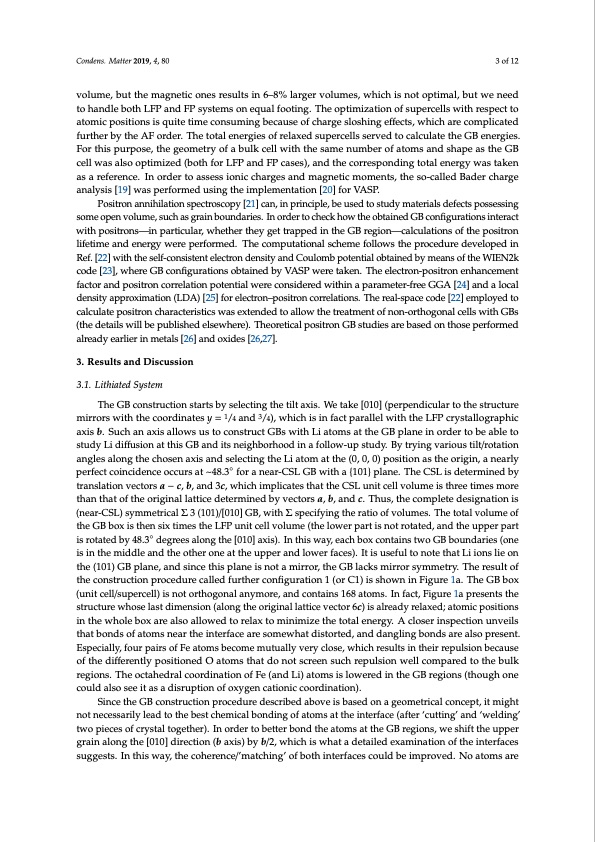
PDF Publication Title:
Text from PDF Page: 003
Condens. Matter 2019, 4, 80 3 of 12 volume, but the magnetic ones results in 6–8% larger volumes, which is not optimal, but we need to handle both LFP and FP systems on equal footing. The optimization of supercells with respect to atomic positions is quite time consuming because of charge sloshing effects, which are complicated further by the AF order. The total energies of relaxed supercells served to calculate the GB energies. For this purpose, the geometry of a bulk cell with the same number of atoms and shape as the GB cell was also optimized (both for LFP and FP cases), and the corresponding total energy was taken as a reference. In order to assess ionic charges and magnetic moments, the so-called Bader charge analysis [19] was performed using the implementation [20] for VASP. Positron annihilation spectroscopy [21] can, in principle, be used to study materials defects possessing some open volume, such as grain boundaries. In order to check how the obtained GB configurations interact with positrons—in particular, whether they get trapped in the GB region—calculations of the positron lifetime and energy were performed. The computational scheme follows the procedure developed in Ref. [22] with the self-consistent electron density and Coulomb potential obtained by means of the WIEN2k code [23], where GB configurations obtained by VASP were taken. The electron-positron enhancement factor and positron correlation potential were considered within a parameter-free GGA [24] and a local density approximation (LDA) [25] for electron–positron correlations. The real-space code [22] employed to calculate positron characteristics was extended to allow the treatment of non-orthogonal cells with GBs (the details will be published elsewhere). Theoretical positron GB studies are based on those performed already earlier in metals [26] and oxides [26,27]. 3. Results and Discussion 3.1. Lithiated System The GB construction starts by selecting the tilt axis. We take [010] (perpendicular to the structure mirrors with the coordinates y = 1/4 and 3/4), which is in fact parallel with the LFP crystallographic axis b. Such an axis allows us to construct GBs with Li atoms at the GB plane in order to be able to study Li diffusion at this GB and its neighborhood in a follow-up study. By trying various tilt/rotation angles along the chosen axis and selecting the Li atom at the (0, 0, 0) position as the origin, a nearly perfect coincidence occurs at ~48.3◦ for a near-CSL GB with a {101} plane. The CSL is determined by translation vectors a − c, b, and 3c, which implicates that the CSL unit cell volume is three times more than that of the original lattice determined by vectors a, b, and c. Thus, the complete designation is (near-CSL) symmetrical Σ 3 (101)/[010] GB, with Σ specifying the ratio of volumes. The total volume of the GB box is then six times the LFP unit cell volume (the lower part is not rotated, and the upper part is rotated by 48.3◦ degrees along the [010] axis). In this way, each box contains two GB boundaries (one is in the middle and the other one at the upper and lower faces). It is useful to note that Li ions lie on the (101) GB plane, and since this plane is not a mirror, the GB lacks mirror symmetry. The result of the construction procedure called further configuration 1 (or C1) is shown in Figure 1a. The GB box (unit cell/supercell) is not orthogonal anymore, and contains 168 atoms. In fact, Figure 1a presents the structure whose last dimension (along the original lattice vector 6c) is already relaxed; atomic positions in the whole box are also allowed to relax to minimize the total energy. A closer inspection unveils that bonds of atoms near the interface are somewhat distorted, and dangling bonds are also present. Especially, four pairs of Fe atoms become mutually very close, which results in their repulsion because of the differently positioned O atoms that do not screen such repulsion well compared to the bulk regions. The octahedral coordination of Fe (and Li) atoms is lowered in the GB regions (though one could also see it as a disruption of oxygen cationic coordination). Since the GB construction procedure described above is based on a geometrical concept, it might not necessarily lead to the best chemical bonding of atoms at the interface (after ‘cutting’ and ‘welding’ two pieces of crystal together). In order to better bond the atoms at the GB regions, we shift the upper grain along the [010] direction (b axis) by b/2, which is what a detailed examination of the interfaces suggests. In this way, the coherence/’matching’ of both interfaces could be improved. No atoms arePDF Image | First-Principles Grain Boundary Formation in the Cathode Material LiFePO4

PDF Search Title:
First-Principles Grain Boundary Formation in the Cathode Material LiFePO4Original File Name Searched:
condensedmatter-04-00080.pdfDIY PDF Search: Google It | Yahoo | Bing
Sulfur Deposition on Carbon Nanofibers using Supercritical CO2 Sulfur Deposition on Carbon Nanofibers using Supercritical CO2. Gamma sulfur also known as mother of pearl sulfur and nacreous sulfur... More Info
CO2 Organic Rankine Cycle Experimenter Platform The supercritical CO2 phase change system is both a heat pump and organic rankine cycle which can be used for those purposes and as a supercritical extractor for advanced subcritical and supercritical extraction technology. Uses include producing nanoparticles, precious metal CO2 extraction, lithium battery recycling, and other applications... More Info
| CONTACT TEL: 608-238-6001 Email: greg@infinityturbine.com | RSS | AMP |